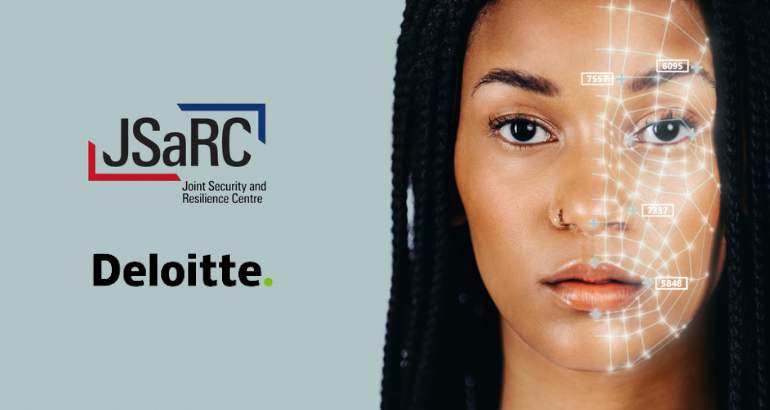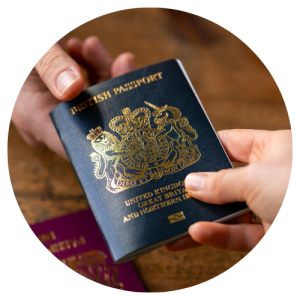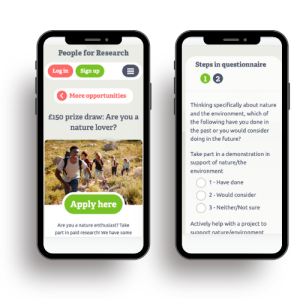Recruiting hundreds of participants for one of the UK’s largest ever biometric trials
18th September 2023

Back in November 2021, People for Research worked closely with Deloitte who were responsible for organising one of the biggest trials of biometric technology ever conducted in the UK for their client, the Home Office’s Joint Security and Resilience Centre (JSaRC). The overall goal: to stimulate innovation in the industry of self-enrolment biometric technology solutions to support future visa application processes.
According to the Home Office’s case study, the agency’s “ambition is that all visitors and migrants will provide their biometric facial images and fingerprints under a single global immigration system ahead of travel to the UK, utilising remote self-enrolment for those who are not required to apply for a visa as part of an ecosystem of enrolment options.”
Add to this the fact that technology is ever-changing and improving and it’s easy to understand why Deloitte was tasked by the Home Office with conducting practical research to test the solution readiness and prompt further innovation in the biometrics technology industry.
📣 “The trials are a crucial step for the Future Border and Immigrations System, and wider Home Office, towards realising our ambitions for biometrics and transforming our system to ensure we are world-leading.”
Nigel Farminer, Head of Border Security and Identity Policy
The mission & initial challenges
Following the initial brief from Deloitte, People for Research were tasked with recruiting over 500 participants to attend face-to-face user testing in Manchester, spread across five working days in November 2021.
This would have been a challenging task in any normal circumstances due to the high-volume of recruitment and the complex logistics involved, but don’t forget we were still dealing with COVID-19 and people were being asked to attend in-person research for a total of eight hours for £100 (comparatively, a modest incentive for a whole day of research), which would drastically reduce our pool of interested and available participants.
Pandemic-related safety measures were required on the day, which involved presenting a negative lateral flow test (LFD), wearing a mask and sticking to social distancing as much as possible. This presented an added challenge, as some people weren’t familiar with registering a negative LFD result, would struggle to get hold of tests in time, didn’t want to wear a mask, or got cold feet on the day due to health concerns, etc.
 Due to the nature of biometrics involving the unique and measurable physical characteristics of an individual (such as facial features and fingerprints), a diverse sample of participants with a range of demographic characteristics were needed to test the effectiveness of the technology across these demographics. Hence, Deloitte tasked our team with the Home Office’s diverse recruitment target, requiring a higher representation of people from demographic minority groups relative to UK national representation.
Due to the nature of biometrics involving the unique and measurable physical characteristics of an individual (such as facial features and fingerprints), a diverse sample of participants with a range of demographic characteristics were needed to test the effectiveness of the technology across these demographics. Hence, Deloitte tasked our team with the Home Office’s diverse recruitment target, requiring a higher representation of people from demographic minority groups relative to UK national representation.
The Home Office brief required us to ideally recruit an equal breakdown of ethnicities (20% splits across five groups – Asian, Black, Mixed, White and Other, as per the Office for National Statistics ethnic background groupings) in a region of England that is over 65% white. On top of this requirement, the need to benchmark the newly-captured biometric data against that held on passports to evaluate accuracy meant that all participants had to have a valid UK passport. This constraint further reduced the pool of ethnically diverse participants that would be eligible to participate in the trials.
Finally, all ethnic splits would ideally be balanced in terms of sex and age bracket, where possible. We realise this a challenging list of layered criteria in a challenging context, but if experience has taught us anything is that the trick to successfully climbing the mountain is planning the best route (and, sometimes, the right detour) to take. It’s the same with user recruitment: as long as you are aware of the challenges ahead, you can plan for them.
Enter plan A
Before jumping straight into recruitment, we did some essential prep work. This involved:
📌 Having a few initial calls with the Deloitte team to ensure we fully understood the Home Office’ requirements and what were the must-haves versus the nice-to-haves.
📌 Creating a robust and detailed recruitment brief with the client where we detailed all the project requirements – with multiple people contributing to a complex high-volume project, it was essential to have a centralised document with all the relevant information.
📌 Defining how we would handle GDPR, data privacy and informed consent in a context where a client is collecting a large set of identifiable data, including special category data as part of the research.
📌 Developing a complete screener where we detailed to the client what we would ask the participants during the pre-qualification stage.
📌 Setting up and adapting our user recruitment processes and documents according to the very specific needs of this project.
📌 Finding a way to guarantee that the client would have a valid sample by the end of the project: Deloitte needed the input from at least 500 participants, but we knew there was a high likelihood of some drop-outs due to the nature of the project and all the challenges listed in this case study. We suggested recruiting at least 150 participants free of charge that the client would only pay for in case they attended, plus build a pool of readily available participants that we could recruit from at the last minute.
📌 Lastly, we identified the £100 incentive for a whole day of participation might not be enough to both maximise people’s interest in the project and keep them from dropping out. At this stage, raising the incentive even just by half was not possible because the project’s budget was set in stone, but there was a bit of wiggle room, so we suggested to Deloitte running five £500 prize draws, one for each day of research. All participants who successfully attended and stayed for the whole day would be entered into a prize draw the next day and PFR would select a random winner.
As soon as the team felt we were in a good place to kick off recruitment, we started by reaching out to our UK database. This part of the recruitment process was pretty standard: the documents and goals were shared with our digital marketing team, so they could use their expertise to craft the perfect communication strategy.
People for Research is one of the few user recruitment agencies in the UK to count with a full team of digital marketing/communication and growth professionals, and this resource makes all the difference when tasked with challenges like this project. Here’s an example of advice we shared in the past to take your user recruitment content to the next level.
 Our moderated recruitment process usually includes an online pre-qualifying questionnaire, followed by a screening call. However, to keep costs down for the Home Office and to cut down on recruitment lead time, we suggested skipping the screening calls and focussing our efforts on a foolproof online screener and a consistent communication strategy to keep the participants engaged between receiving the invite and attending their chosen research date.
Our moderated recruitment process usually includes an online pre-qualifying questionnaire, followed by a screening call. However, to keep costs down for the Home Office and to cut down on recruitment lead time, we suggested skipping the screening calls and focussing our efforts on a foolproof online screener and a consistent communication strategy to keep the participants engaged between receiving the invite and attending their chosen research date.
Why skip such an important step like telephone screening at this stage? – you might ask. Basically, the pros of skipping this screening step outweighed the cons. Telephone screening is an essential tool for behaviour-based recruitment, but when dealing with purely demographical requirements, the likelihood of PFR mis-recruiting participants for this project was close to zero. This would only happen if participants were not truthful about their nationality or passport validity at the online screening stage, but doing that would result in them not being able to participate on the day so there was no downside (or cost) for the client if that happened.
The first batch of invites to our internal database in Manchester and surrounding areas produced the expected results: a good amount of interest in the project and a representative sample of the local demographics. The first results were positive, but we knew we needed to ramp up the ethnic diversity.
Time for free find
At People for Research, we call the process of recruiting new participants outside our database ‘free find’. It does what it says on the tin: it means we use every method to make sure we find the right participants for each project.
Resorting to free find was always part of the plan, as we knew we would have to boost some ethnic splits via other means other than our database, so we were fully prepared to go ahead with this as soon as we analysed the first wave of internal response to the online screener.
Our first batch of free find measures included the following:
▪️ We ran multiple advertising campaigns across all our key social media platforms – Facebook, Instagram and Twitter.
▪️ Instead of advertising the specific project, we went with brand awareness campaigns to start building trust with new participants as they were finding out more about us: the purpose was to explain who People for Research are and encourage people to sign up to our database. This built both initial trust and allowed us to start building a relationship with the individuals that came from these social media campaigns.
▪️ We tested a social media tool that PFR had not explored yet – TikTok.
▪️ We posted on platforms like online forums and digital job boards to spread the word or share sponsored posts.
▪️ We launched a referral scheme, where people could refer their friends and family to take part in the project and get rewarded for their efforts.
This boosted our ethnic diversity and allowed us to kick off recruitment and start booking participants. It was time to focus on the next step of our plan: keeping the participants engaged between the booking stage and the day of research and doing our best to reduce the number of drop-outs.
Continuous engagement strategy
Whether you are recruiting a handful of people or hundreds of participants to attend research, drop-outs are always a possibility; but the more people you need to recruit, the more likely you are to face this issue. The answer to curb the numbers is a good communication strategy, which for us included:
▪️ Initial engagement stage
1. Email invites to the people in the right locations with all the relevant information, including a data privacy notice, which allowed people to make an informed decision at the beginning of the process.
2. Email confirmation of suitability, inviting people to confirm their preferred date and starting time to attend, followed by a reminder text to anyone who missed the initial email. This email mentioned the exact address of the research and a reminder of all requirements, including the data sharing requirements.
3. Email confirming participant is attending on their selected date and time, plus resources on how to order lateral flow tests and how to register their negative results.
▪️ Intermediate stage
1. Some participants confirmed their attendance quite early in the process, which meant more time to forget their commitment. To avoid this, we included an intermediate stage email and text to remind them that they were due to take part in the project within, for example, a week.
2. At this stage, we reminded them that rescheduling was easy in case something came up and cancelling their attendance was not a problem. It was important to make it easy for the participants to update us in case their plans changed, so we could act immediately and replace them.
▪️ Final stage (two working days before the research)
1. At this stage, it was important to reinforce our communication with the participants and remind them of everything they had to bring on the day of the research.
2. Our communication schedule included an email two days before each of the research dates, an email and text the day before and a text on the day providing easy access to the address and an on-site contact number the participants could call in case they got lost. We also reminded them they had to bring a negative lateral flow test and their valid passport to the research.
3. Not having the negative lateral flow was not a major issue, since Deloitte had a few tests available on site and could help the handful of participants that had forgotten or didn’t have access to a test in time, but forgetting the passport made it impossible for participants to attend the session, so we made sure to remind them at every step of the way.
Onto the next challenge
At this stage, the response was overall positive and the recruitment was progressing nicely, but we were still struggling with a few groups: Black, mixed and other ethnicities (such as people with an Arab background) and the older age bracket, the 55+ plus years old.
Here are the three pivotal campaigns that further helped to improve the diversity of our pool of participants:
 ▪️ Physical advertising
▪️ Physical advertising
After researching the demographic representation of different Manchester areas, flyers were posted to targeted postcodes to encourage individuals with specific ethnic backgrounds to sign up to our database. The conversions that resulted from that were both high quality and reliable.
▪️ Boosted referrals
We reinforced our referral scheme and increased the referral fee for anyone who successfully referred participants with specific demographic characteristics. The scheme helped us recruit over 60 suitable participants in total, with a focus on these more hard-to-reach groups.
▪️ Charity engagement
PFR worked alongside the Manchester Refugee Support Network to recruit people from a range of ethnic backgrounds. Our Community Marketing Manager arranged a face-to-face information day with the charity to help support individuals signing up to our database. This day was instrumental in helping to address any potential concerns or apprehensiveness with attending research with the Home Office while also helping individuals with low digital skills (mostly the older age bracket) to sign up.
📣 “The in-person meeting helped us to access participants that otherwise would have given up or been suspicious of the process. It was a great day helping people and doing something extraordinary to recruit people for research!”
Leona, PFR’s Community Marketing Manager
The week of the research
At this stage, we were three working days away from the beginning of the research and had secured a diverse group of 650 participants to attend the sessions on the following week. We had rescheduled dozens of participants and dealt with some cancellations: some participants’ availability changed, some changed their minds about sharing this kind of data with the Home Office, and some emailed us to let us know that their passport was actually expired, among other reasons.
As we replaced the cancelations, we started gearing up for the first day of in-person research and tried to forecast how many drop-outs we would have on the day. Knowing the real percentage of people who cancelled in the morning or didn’t show up throughout the day later helped us define our last-minute approach for the remaining four days of research.
As we navigated the actual week of the research, we were able to keep the participation numbers healthy thanks to our pool of standby participants and some very agile last-minute bookings.
Conclusion & summary
Overall, we ended up booking a total of 920 participants, which equals an over-recruit amount of 41.5%, well above the contracted amount. The final number of participants who attended the research was 545.
📣 “To have 545 members of the public take part in the trials, across a broad range of demographics, was a great achievement and could not have been reached without PFR’s tireless and innovative approach.”
Nigel Farminer, Head of Border Security and Identity Policy
Here are a few things that really helped us coordinate this massive project:
▪️ Organisation
We made sure the people working on this project knew exactly what their responsibilities were and had all the necessary support, which kept the team united and positive while recruitment progressed. To keep everyone focussed on the project’s target, we even drew a big funnel on our office wall and kept filling it up with participants every time we recruited an extra 100 people, providing the team with small treats for each victorious step. Creating a visual objective helped us rally the troops around the collective goal – recruiting those participants was our mission. It felt pretty good once that funnel was full!
📣 “The hospitality on the day was superb, the technology was really interesting and it was well organised.”
Alan, one of the participants who took part in the research
▪️ Flexibility
This covers a lot of aspects of this project, from some of us having to take on temporary responsibilities to being flexible in how we use our templated documents. A good example is how we tailored our recruitment tracking document to allow us to capture specific data and share that with the client in real time by giving them access to a live list of participants.
▪️ Recording
One of our top tips if you ever have to work on a mammoth project like this: record everything! Literally down to how many times you have texted a participant – this will make all the difference between looking professional versus ‘not really sure what’s happening here’. As mentioned in the previous point, modifying our recruitment tracking documents to allow us to log every email, text or call made a huge difference in how multiple team members were able to keep up to date with our communication strategy without having to ask for the tenth time “have you confirmed this participant?”.
▪️ Technology
Ok, you can hardly call Excel state-of-the-art tech… but it was a life-saver on this occasion. By applying some smart formulas to our recruitment tracking documents, our documents started doing the data analysis on our behalf. With so many requirements to balance out, having those formulas in place meant that every time we recruited more participants, we could see how accurately we were delivering the desired splits. Once again, having a shared document allowed both our team and the client to see these splits being delivered in real-time and facilitated communication between the parties.
▪️ Ethics & data protection
When recruiting for any research, you are likely to come across participants who are unsure about sharing their personal data with an organisation they have never heard of. People have become extremely aware of their right to data privacy, especially since the introduction of GDPR, and you can only imagine how a project where you are being asked to share your identifiable details, facial features and fingerprints might make some people think twice. Something we have known for a long time is that trying to attract participants to take part in sensitive research where special category data is being targeted without providing all the information upfront is a waste of time: people won’t overlook their right to privacy just because we offer them an incentive. Ensuring participants are making informed decisions and are fully confident and comfortable with whatever they are being asked to do is, more than ever, a key pillar of our recruitment process.
▪️ Communication with the client
Knowing all the details about the research schedule and how flexible the client could be was extremely helpful to help us make decisions independently during the recruitment. The client was kept up to date at all stages thanks to the shared documents and daily summaries. This strategy became especially important after the first few couple of days of research, as the client started confirming attendance and drop-out rates – thanks to quick communication between teams, PFR were able to dip into our standby participant pool and quickly over-recruit for the remaining research dates to curb the average drop-out rate.
Overall, the People for Research team are all incredibly proud of what was achieved in collaboration with Deloitte for this pivotal user research. It demonstrated that despite logistical, demographic, and contextual challenges, creative solutions and innovative thinking, along with a determined team, can lead to a successful outcome for all.
📣 “The success of these trials and the insights provided have brought the Home Office closer to achieving its ambition of remote self-enrolment… It is hoped that by continuing to work with industry and by piloting new solutions, current self-enrolment technology will improve to be in a production-ready state within the next one to three years. […] The Home Office’s ambition is that all visitors and migrants will provide their biometric facial images and fingerprints under a single global immigration system ahead of travel to the UK, utilising remote self-enrolment.”
Home Office’s case study on the trial
In the words of one of our Manchester participants, Jawad: “I found the research really interesting and felt like it benefitted the future of travel for the UK.”
Thanks to our participation in this project and following our win in 2019, we were nominated for another industry award at the 2022 Market Research Society’s Oppies (the nickname for the organisation’s Operations Awards).
 Madeleine Tilbury, Community Marketing Manager
Madeleine Tilbury, Community Marketing Manager
If you would like to find out more about our in-house participant recruitment service for user testing or market research get in touch on 0117 921 0008 or info@peopleforresearch.co.uk.
At People for Research, we recruit participants for UX and usability testing and market research. We work with award winning UX agencies across the UK and partner up with a number of end clients who are leading the way with in-house user experience and insight.


